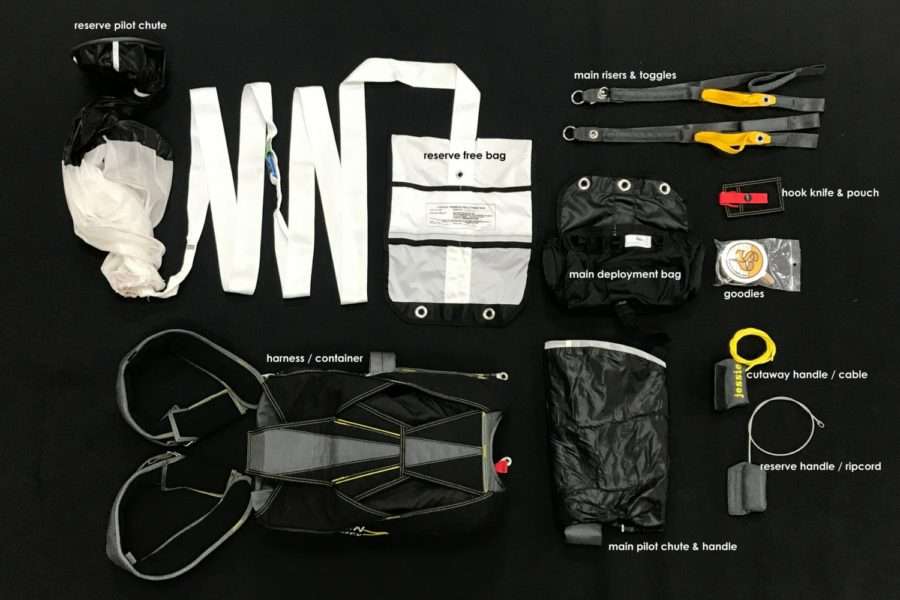So you’ve made those first few jumps, felt the unequalled exhilaration of freefall, the signature pump of adrenaline through your veins, landed back on earth but not quite the same and now… you’re hooked on skydiving. Whether you’ve been using rental or borrowed equipment, it’s now time to get some gear of your own. After all, it’s more than a hobby, it’s a lifestyle! There are many considerations for purchasing your first set of skydiving gear, and it’s important to get it right both for safety and cost considerations.
You probably have many questions – should I buy new or used? What are the considerations when purchasing a rig? We’re going to cover all the basics, so you’ve come to the right place.
Let’s start at the top.
1. Helmet and Goggles
A hard shell helmet is a mandatory requirement during the early stages of your skydiving career, so getting a correctly sized and comfortable helmet to fit your noggin is essential. Clean and clear goggles are important as you want to have a good field of view. The helmet should fit well and remain snug to your head with an accessible, but secure clasp.
We recommend buying these two items new, as they will be in close contact with your face, but often you can purchase good secondhand helmets. They also won’t set you back too much on price, so it’s worth investing in something quality you’ll have for a long time. Seek advice from your Instructor or DZ owner/operator on quality brands.
2. Jumpsuit
A good jumpsuit serves many purposes. The right tool for the right job! Firstly, it offers a basic level of protection from scratches and abrasions that occur… especially on landing! Secondly, it can help control fall rate, assist in directional control and provide hand grips for group jumps.
If you’re just starting out, a jumpsuit is something you can purchase used (if you find one that’s a good fit.) As a new skydiver, it’s also worth investing a little time in researching what jumpsuit best suits your body type and weight as the wrong jumpsuit can really negatively affect your jumps.
3. The Rig
A rig is what separates you from Tom Cruise jumping out of a plane in just a t-shirt and aviators. Your rig is your lifeline and your most important piece of skydiving gear, so it’s worth investing quite a bit of time researching to find one suited to you and your experience level.
A rig consists of a:
- Container / Harness system (the backpack that holds the canopies)
- Reserve canopy
- AAD (Automatic Activation Device)
- Main canopy

Image Courtesy of Sun Path
– Canopies
We could go on about choosing canopies for an entire article, but for now, the most important aspects to consider are your experience level and weight which will determine the best canopy for you. Your instructors will tell you that you’ll need to demonstrate canopy control with lower wing loading before moving to a smaller canopy. Instructors or riggers (like us here at Downward Trend) will be your best guide for buying these.
*Tip: Never buy your first canopy without consulting experienced people in the sport.
– Harness/Container
A harness/container is the backpack that your canopies are packed into with a harness that holds the container onto your body. The most important thing when buying a harness/container is having a harness that fits your body and the right size for the canopies you will be using. Don’t buy your harness/container before you confirm what size canopies you will be using as there are many different sizes of harness/containers and each model is designed to hold specific size canopies.
– Automatic Activation Device (AAD)
The AAD is an essential piece of equipment when starting out in skydiving. The AAD is a backup device that has a preset activation altitude and will initiate the deployment of your reserve parachute if you have not activated your main or reserve canopy before you reach this preset altitude. If you have an incident that may cause you to lose consciousness or even just lose track of your altitude, the AAD can literally save your life!
4. Altimeter and Audible Altimeter
Your altimeter is a mandatory piece of equipment that measures your altitude above the ground so you know when to deploy your canopy. There are many reputable altimeters on the market, and most manufacturers provide both visual altimeters and audible altimeters. Visual altimeters are usually worn on your wrist and audible altimeters are worn in your helmet and beep in your ear! Usually, a skydiver will only have to make this purchase once or twice in their life, so we recommend investing in a quality one that’s easy for you to read… you know… while falling through the sky.
New or Used Skydiving Gear?
There’s no way around it, skydiving gear is expensive. While new gear is custom made and tailored to your exact needs, a completely new set-up can cost you anywhere from $10,000 AUD to upwards of $13,000 AUD or more. Luckily, there is a great secondhand market in Australia, and you can normally find good quality gear from around $5,500 to $7,500.
If you are going to buy used gear, our one request is that you have it inspected by a trusted rigger prior to purchase. Remember, if a deal seems too good to be true, it probably is.
Downward Trend is here to help
At Downward Trend, we live and breathe skydiving equipment and would be happy to walk you through the ins and outs of purchasing your gear. Brett and the team have been skydiving for over 30 years. Along the way, we’ve picked up a thing or two, so come in have a chat, and we’ll be sure to sort you out.
Phone
0400 011 331
